Abstract
Research Article
Effectiveness of different cord care interventions on omphalitis prevention among neonates in Nakuru County Hospital, Kenya
Lucy Kinanu*, James Mwaura, Anne Karani and Margaret Chege
Published: 05 May, 2022 | Volume 5 - Issue 1 | Pages: 015-021
Background: Sepsis among newborns is common and a major cause of neonatal deaths in developing countries. Annually, about 4 million neonatal deaths occur around the world. Of these, more than 30% are caused by infections majority of which start as umbilical cord infections. Topical umbilical cord care can reduce omphalitis (umbilical cord infection) and neonatal mortality among newborns.
Objective: This study aimed to compare the incidence of omphalitis in different cord care interventions (Dry, Chlorhexidine, and Alcohol) in Nakuru County, Kenya.
Methodology: A randomized controlled trial was carried out between July 2018 and June 2019. A total of 540 newborns were randomly assigned to receive 1 of 3 cord care regimens; twice cord cleansing with 4% chlorhexidine (Group 1), twice cord cleansing with 70% alcohol (Group 2), and dry cord care (Group 3) as control.
Results: The risk of omphalitis was significantly reduced in the chlorhexidine group than in dry and alcohol cord care groups. The incidence of omphalitis was 1.95 times more likely to occur among the dry cord care group [AOR = 1.95; 95% CI = 1.13-3.38; p = 0.017] compared to the chlorhexidine group. Similarly, babies in the alcohol group were nearly 2 times more likely to develop omphalitis [AOR = 1.98; 95% CI = 1.15-33.40; p = 0.014] compared to those in the chlorhexidine group.
Conclusion and recommendation: Chlorhexidine topical cord care significantly reduces the risk of umbilical infection in neonates when compared to both topical alcohol application and dry cord care approach. It should be recommended to be used topically for the prevention of omphalitis in our setup.
Read Full Article HTML DOI: 10.29328/journal.japch.1001046 Cite this Article Read Full Article PDF
Keywords:
Alcohol; Chlorhexidine; Dry care; Omphalitis; Topical umbilical cord care
References
- UNICEF, WHO, World Bank, and United Nations (2011), Levels and Trends in Child Mortality, UNICEF, New York, NY, USA.
- Kenya Demographic and Health Survey (KHDS) 2014.
- Committing to Child Survival (2012) A Promise Renewed Progress Report: African Leadership for Child Survival. http://apromiserenewed.org
- World Health Organization; Geneva, Switzerland.World Health Organization. (2012). Care of the umbilical cord. Maternal and new born health/safe motherhood. World Health Organization; Geneva, Switzerland.
- Mullany LC, Darmstadt GL, Katz J, Khatry SK, Leclerq SC, Adhikari RK, Tielsch JM. Risk of mortality subsequent to umbilical cord infection among newborns of southern Nepal: cord infection and mortality. Pediatr Infect Dis J. 2009 Jan;28(1):17-20. doi: 10.1097/INF.0b013e318181fb4c. PMID: 19034065; PMCID: PMC2680481.
- World Health Organization. Recommendations on Postnatal care of the mother and new born. 2013.
- Karumbi J, Mulaku M, Aluvaala J, English M, Opiyo N. Topical umbilical cord care for prevention of infection and neonatal mortality. Pediatr Infect Dis J. 2013 Jan;32(1):78-83. doi: 10.1097/INF.0b013e3182783dc3. PMID: 23076382; PMCID: PMC3785148.
- Gelano TF, Bacha YD, Abate D. Effect of chlorhexidine cord application on prevention of neonatal sepsis in developing countries: Systematic review and meta-analysis. Int J Health Sci (Qassim). 2019 Jan-Feb;13(1):40-51. PMID: 30842717; PMCID: PMC6392487.
- Roba AA, Tefera M, Worku T, Dasa TT, Estifanos AS, Assefa N. Application of 4% chlorhexidine to the umbilical cord stump of newborn infants in lower income countries: a systematic review and meta-analysis. Matern Health Neonatol Perinatol. 2019 Oct 17;5:16. doi: 10.1186/s40748-019-0111-y. Retraction in: Matern Health Neonatol Perinatol. 2020 Jun 16;6:4. PMID: 31641528; PMCID: PMC6796424.
- Mullany LC, Arifeen SE, Khatry SK, Katz J, Shah R, Baqui AH, Tielsch JM. Impact of Chlorhexidine Cord Cleansing on Mortality, Omphalitis and Cord Separation Time Among Facility-Born Babies in Nepal and Bangladesh. Pediatr Infect Dis J. 2017 Oct;36(10):1011-1013. doi: 10.1097/INF.0000000000001617. PMID: 28430753; PMCID: PMC5600668.
- Khairuzzaman M, Rouf Ma, Sarker Mma. Chlorhexidine Cleansing of the Umbilical Cord for Prevention of Umbilical Infection: A Hospital based Study in Bangladesh Bangladesh j Child Health; 2018; 42(1): 4-8.
- Arifeen SE, Mullany LC, Shah R, Mannan I, Rahman SM, Talukder MR, Begum N, Al-Kabir A, Darmstadt GL, Santosham M, Black RE, Baqui AH. The effect of cord cleansing with chlorhexidine on neonatal mortality in rural Bangladesh: a community-based, cluster-randomised trial. Lancet. 2012 Mar 17;379(9820):1022-8. doi: 10.1016/S0140-6736(11)61848-5. Epub 2012 Feb 8. PMID: 22322124.
- Sazawal S, Dhingra U, Ali SM, Dutta A, Deb S, Ame SM, Mkasha MH, Yadav A, Black RE. Efficacy of chlorhexidine application to umbilical cord on neonatal mortality in Pemba, Tanzania: a community-based randomised controlled trial. Lancet Glob Health. 2016 Nov;4(11):e837-e844. doi: 10.1016/S2214-109X(16)30223-6. Epub 2016 Sep 29. PMID: 27693438.
- Semrau KE, Herlihy J, Grogan C. Effectiveness of 4% chlorhexidine umbilical cord care on neonatal mortality in Southern Province, Zambia (ZamCAT): a cluster-randomised controlled trial. Lancet Glob Health. 2016;4(11):e827–e836. [PubMed: 27693439].
- McDonnell G, Russell AD. Antiseptics and disinfectants: activity, action, and resistance. Clin Microbiol Rev. 1999 Jan;12(1):147-79. doi: 10.1128/CMR.12.1.147. Erratum in: Clin Microbiol Rev 2001 Jan;14(1):227. PMID: 9880479; PMCID: PMC88911.
- Kinanu L., Odhiambo E. Cord Care Practices and Omphalitisamong Neonates Aged 3 - 28 Days at Pumwani Maternity Hospital, Kenya. J Biosci Med. 2016;4:27-36.
Similar Articles
-
Effectiveness of different cord care interventions on omphalitis prevention among neonates in Nakuru County Hospital, KenyaLucy Kinanu*,James Mwaura,Anne Karani,Margaret Chege. Effectiveness of different cord care interventions on omphalitis prevention among neonates in Nakuru County Hospital, Kenya. . 2022 doi: 10.29328/journal.japch.1001046; 5: 015-021
Recently Viewed
-
Microcystic Meningioma: Atypical Meningioma Revisited. Rare Case Report with Review of LiteratureKaustubh Gupta*. Microcystic Meningioma: Atypical Meningioma Revisited. Rare Case Report with Review of Literature. J Radiol Oncol. 2025: doi: 10.29328/journal.jro.1001079; 9: 046-049
-
Maternal and perinatal outcomes of uterine rupture in Lubumbashi, Democratic Republic of CongoJacques Ngoy Kitenge,Olivier Mukuku*,Xavier K Kinenkinda,Prosper L Kakudji. Maternal and perinatal outcomes of uterine rupture in Lubumbashi, Democratic Republic of Congo. Clin J Obstet Gynecol. 2020: doi: 10.29328/journal.cjog.1001067; 3: 136-141
-
Do Fishes Hallucinate Human Folks?Dinesh R*,Sherry Abraham,Kathiresan K,Susitharan V,Jeyapavithran C,Paul Nathaniel T,Siva Ganesh P. Do Fishes Hallucinate Human Folks?. Arch Food Nutr Sci. 2017: doi: 10.29328/journal.afns.1001003; 1: 020-023
-
Assessment of Redox Patterns at the Transcriptional and Systemic Levels in Newly Diagnosed Acute LeukemiaAna Carolina Agüero Aguilera, María Eugenia Mónaco, Sandra Lazarte, Emilse Ledesma Achem, Natalia Sofía Álvarez Asensio, Magdalena María Terán, Blanca Alicia Issé, Marcela Medina, Cecilia Haro*. Assessment of Redox Patterns at the Transcriptional and Systemic Levels in Newly Diagnosed Acute Leukemia. J Hematol Clin Res. 2024: doi: 10.29328/journal.jhcr.1001029; 8: 017-023
-
Assessment of Indigenous Knowledge on Using of Traditional Medicinal Plants to Cure Human Diseases in South Omo Zone Baka Dawla Ari District, Kure and Bitsmal South EthiopiaGizaw Bejigo*. Assessment of Indigenous Knowledge on Using of Traditional Medicinal Plants to Cure Human Diseases in South Omo Zone Baka Dawla Ari District, Kure and Bitsmal South Ethiopia. J Plant Sci Phytopathol. 2024: doi: 10.29328/journal.jpsp.1001132; 8: 048-054
Most Viewed
-
Evaluation of Biostimulants Based on Recovered Protein Hydrolysates from Animal By-products as Plant Growth EnhancersH Pérez-Aguilar*, M Lacruz-Asaro, F Arán-Ais. Evaluation of Biostimulants Based on Recovered Protein Hydrolysates from Animal By-products as Plant Growth Enhancers. J Plant Sci Phytopathol. 2023 doi: 10.29328/journal.jpsp.1001104; 7: 042-047
-
Sinonasal Myxoma Extending into the Orbit in a 4-Year Old: A Case PresentationJulian A Purrinos*, Ramzi Younis. Sinonasal Myxoma Extending into the Orbit in a 4-Year Old: A Case Presentation. Arch Case Rep. 2024 doi: 10.29328/journal.acr.1001099; 8: 075-077
-
Feasibility study of magnetic sensing for detecting single-neuron action potentialsDenis Tonini,Kai Wu,Renata Saha,Jian-Ping Wang*. Feasibility study of magnetic sensing for detecting single-neuron action potentials. Ann Biomed Sci Eng. 2022 doi: 10.29328/journal.abse.1001018; 6: 019-029
-
Pediatric Dysgerminoma: Unveiling a Rare Ovarian TumorFaten Limaiem*, Khalil Saffar, Ahmed Halouani. Pediatric Dysgerminoma: Unveiling a Rare Ovarian Tumor. Arch Case Rep. 2024 doi: 10.29328/journal.acr.1001087; 8: 010-013
-
Physical activity can change the physiological and psychological circumstances during COVID-19 pandemic: A narrative reviewKhashayar Maroufi*. Physical activity can change the physiological and psychological circumstances during COVID-19 pandemic: A narrative review. J Sports Med Ther. 2021 doi: 10.29328/journal.jsmt.1001051; 6: 001-007

HSPI: We're glad you're here. Please click "create a new Query" if you are a new visitor to our website and need further information from us.
If you are already a member of our network and need to keep track of any developments regarding a question you have already submitted, click "take me to my Query."















































































































































